Today we focus on building fast singles! In part 1, we covered playing zones and basic movement. In part 2, we covered basic around patterns. Now, we build upon this foundation and start Read more “How to Play Marching Tenor Drums, Part 3 of 7: Building Fast Singles”
Tag: singles
How to Play Marching Tenor Drums, Part 2 of 7: Around Patterns
In part 1, we started with general movement principles, and we now come to basic around patterns with standard drum rudiments. This is the material I usually show first-time players on day one (exercises included below).
If you have been playing tenors for any length of time, these patterns should Read more “How to Play Marching Tenor Drums, Part 2 of 7: Around Patterns”
2-Mallet Keyboard Exercise: Singles Speed Builder
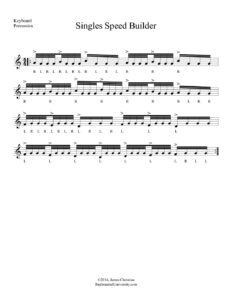
This short exercise is a good chop builder for keyboard percussion. It focuses on short spurts (which builds speed), and its length allows for numerous repetitions (which builds endurance). I came up with this exercise several years ago when I was trying to help a student build their two-mallet speed. I didn’t expect it to be so popular, but my students have enjoyed playing it ever since. It’s fairly catchy, and the simplicity of its structure makes it easy to learn. I have seen firsthand that the students who practice it regularly achieve good results.
When first learning this exercise, take it slowly until you can strike each note with 100% accuracy. It is short enough to memorize fairly easily. Remember that the key to speed is staying relaxed! Of course, you have to push your muscles in order to build endurance, but you must push them with good technique. Don’t let the speed create a sense of uncontrolled frenzy. Don’t lock your arms or wrists. Stay relaxed, yet keep your sound intensely focused. Strive for consistent strokes, so that you achieve clean execution and articulation.
Enjoy playing! I hope you notice significant improvement in your singles quality and speed.
2-Mallet Keyboard Exercise: 12 Bucks (two versions!)
Doubles Version
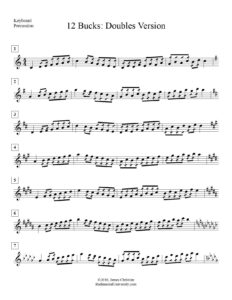
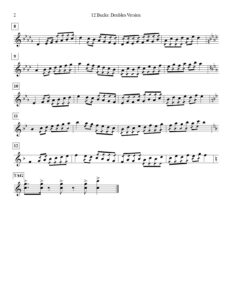
Singles Version
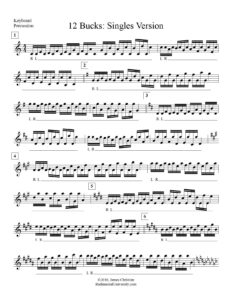
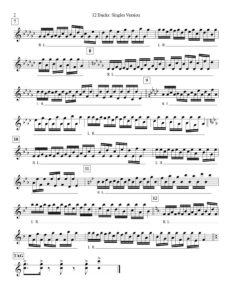
Today you get a double dose of exercises! Both versions cycle through the circle of fifths and utilize a thirds pattern, but the first version uses double strokes, and the second version uses single strokes. Both are valuable to learn, and both work important skills.
As mentioned a few days ago, all the exercises this week can be played individually or together as a full drum line. The snare part is similar to the common “Bucks” exercise, and the keyboard part cycles through 12 keys. Thus the exercise is called “12 Bucks.”
If you don’t know your scales and/or the circle of fifths very well, the main challenge on this exercise will be to switch between keys so quickly. I would recommend starting with the doubles version. You can initially learn it without the double strokes, and the technical demands will be slightly easier. It really is a great exercise for helping you know the circle of fifths intimately.
Once you get the notes down, you can add in the doubles. Then you can learn the slightly more challenging singles version. When playing doubles, make sure both notes are of equal volume. (Don’t “drop” the second note of the doubles.) When playing singles, make sure you don’t add accents when they aren’t written. With everything you play, work toward smooth, evenly spaced notes.
For more seasoned players, you may want to take the same exercises and play them with natural minor, harmonic minor, melodic minor, and/or other scale combinations.
Enjoy!
Multi-Tenors Exercise: Triplet Around Patterns
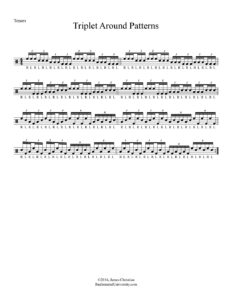
This exercise is a lot of fun to play. It utilizes only four drums, so it can be played on quad-toms, quint-toms, or sex-toms. You especially need two things to play this exercise well:
-
Endurance. As a constant barrage of single strokes, you have to dig deep and keep pushing to the end in order to play this exercise without stopping or slowing down.
-
Fluidity of Movement. Practically every combination of drums is covered here without using crossovers or spock drums. It’s important that you take each pattern slowly until you have the spatial memory to know where you’re going from phrase to phrase. Focus on striking in the proper playing zones and maintaining consistent note spacing.
For added endurance and accuracy practice, play this exercise through 10 times, 20 times, etc. Keep building new goals, and push yourself to get to the next level.
2-Mallet Keyboard Exercise: Interval Focus in Triplets
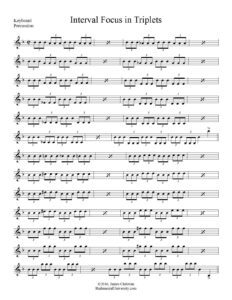
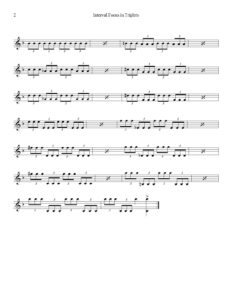
This exercise is great for practicing short and wide interval leaps. It is comprised of three parts:
-
Measures 1-24: The triplet pattern starts on a B-flat (check the key signature!), descends a half step, returns to B-flat, descends two half steps, returns to B-flat, descends three half steps, etc. I would recommend starting this section on the right hand.
-
Measures 25-48: This section follows the same pattern as the previous section, except the intervals move ascending instead of descending. I would recommend starting this section on the left hand.
-
Measures 49-74: Finally, this section also starts on a B-flat, but the intervals both ascend and descend at the same time, ultimately spanning two octaves. I would recommend starting this section on the right hand.
Due to the wide interval, the final two measures are the most difficult to play quickly. I recommend seeing how fast you can play these two measures first. That is your tempo for the entire exercise. While this exercise is good practice for various intervals, another challenge is to maintain a steady tempo. Most people will want to start too quickly and be unable to maintain that tempo throughout the entire exercise. Don’t let that be you!
2-Mallet Keyboard Exercise: Chromatic Singles
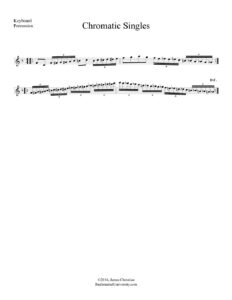
Chromatic scales are an essential skill to master for any keyboardist. Within an octave range, there are 12 notes. This makes sextuplets work nicely for building chromatic speed (6 + 6 = 12). In this particular exercise, your two “target” notes are F-natural and B-natural. Every sextuplet run begins on one of these two notes. If you can visualize these two aiming spots, your accuracy will greatly increase.
When first starting, practice slowly and ensure that you are striking the correct notes. As you gain more confidence in your accuracy, gradually begin to push the tempo. Once you get to the exercise up to a bright tempo, you may want to repeat the last two measures additional times for added endurance.
For the extra motivated, you can transpose the exercise and learn it in all 12 keys.
Snare Exercise: Accented Singles

Accented Singles: One of the Best Things You Can Practice for Any Percussion Instrument
If you want to get the most bang for your buck in practice sessions, devote regular time to working on your accented singles. I think this exercise is extremely helpful for all percussionists, whether you play snare drum, keyboards, timpani, drum set, congas, or anything else.
Why is this exercise so great? Because singles are the foundation of everything. If you can’t play fast singles and control them with accents, then you’re going to have a hard time playing anything else very well. But if you take time and develop your singles, then everything else flows from that foundation.
This exercise has five sections; #1-4 repeat, and #5 adds a final endurance element. If you are a younger player, I would highly recommend playing just #1 over and over again (like for a month or two) until you have it sounding really good and up to a tempo of 100 bpm on the metronome. If you are already at that level, then the remaining sections provide some extra challenges with accent control and pure endurance.
At the end of the exercise, you will notice there is a “D.C.” marking—which, of course, means to go back to the very beginning and play the entire exercise again. On the second lap, follow the bottom sticking. The first time through the exercise, you will play everything with right hand lead, and the second time through, you will play everything with left hand lead. At faster tempos, this thing is a workout!
One important note about the accents: Play them! Few things sound worse than weak accents. Make a clear distinction between your accents and taps. For optimal speed, keep your taps low and close to the drum head. Take care to bring out every accent so that the rhythm is clear.
I believe it’s vitally important to practice this exercise on a single surface, such as a snare drum, because the up-and-down motion is a vital skill to master. Once you can play it well on one surface, you may want to practice it on other percussion instruments, such as multi-tenors, timpani, drum set, or keyboards. You can practice by keeping the taps on one surface and moving the accents to another surface. (You could also do the same with the rims on a snare drum.)
Finally, playing accented triplets is especially important because you have to alternate hands, and you end up working both hands equally. I would recommend adding this exercise (at least #1) to your daily practice routine. Over the course of a few weeks, you should see significant improvement on snare drum and all percussion instruments that you play.


